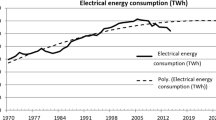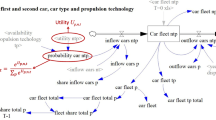Summary
Worldwide, 90 % of used energy in the transport sector have its origin in oil and its by products (Vleit, 2010). Therefore, the negative environmental impacts, the increase of oil prices, the shortage/lack of economically feasible oil resources are key drivers for further development of alternative transport solutions (currently, the focus lies on electric vehicles (EVs)). The integration of EVs thus, must be realized with optimal technical (impact on low and medium voltage grid) and economical (reasonable revenues to lower battery costs) solutions. A successful economical integration needs suitable and grid friendly business models. Therefore, the aim of this work is the definition and economic analysis of this kind of business models, which include the participation of EVs on the markets for ancillary services. The calculations are based on the definition of actor roles and their relationship, the trend of energy prices in different periods (summer, winter), ancillary services in the control area of APG (Austrian Power Grid) in combination with their energy and power prices, the battery characteristics (Li-Ion battery) and charging/discharging power of EVs. The simulation results indicate that maximum profits (median values) generated on the APG-Zone for positive regulation power are in the range 5.7 – 61.5 € per vehicle and month whereas the profits for negative regulation power (mean energy price for regulation: 70.5 €/MWh) would amount to –7.3 – 26.4 € per vehicle and month.
Zusammenfassung
Weltweit sind mehr als 90 % der verbrauchten Energie im Verkehrssektor Öl bzw. dessen Produkten zuzuordnen (Vleit, 2010). Die negativen Umweltaspekte (Treibhausgasemissionen, Luftpartikel), der Anstieg des Ölpreises und die Verknappung der wirtschaftlich förderbaren Ölressourcen führen zur Weiterentwicklung von alternativen Antriebssträngen im Bereich der Personenkraftwagen (derzeit vor allem Elektrofahrzeuge). Die Anbindung und Integration der Elektrofahrzeuge ist dementsprechend mit optimalen technischen (geringer Einfluss auf Nieder- und Mittelspannungsnetze) und wirtschaftlichen (geeignete Erlösmodelle zur Senkung der Batteriekosten) Lösungen zu koppeln. Für eine erfolgreiche wirtschaftliche Integration werden adäquate und netzfreundliche Geschäftsmodelle benötigt. Daher beschäftigt sich dieser Beitrag mit der Definition und wirtschaftlichen Bewertung solcher Geschäftsmodelle, die eine Teilnahme der Elektrofahrzeuge an den Regelenergiemärkten ermöglichen. Ausgehend von der Definition der Akteure und deren Wechselwirkungen bilden die saisonalen Strompreisverläufe (Sommer und Winter), der Abruf der Regelenergie in der APG-Regelzone und deren Leistungs- und Energiepreise, die Batterieeigenschaften sowie die Lade- und Entladeleistung der Fahrzeuge die Grundlage für die durchgeführten Berechnungen. Die Simulationsergebnisse zeigen, dass der maximale Profit (Medianwert) pro Fahrzeug zwischen 5,7 und 61,5 €/Monat für die Bereitstellung von positiver Regelenergie liegt. Die Bereitstellung von negativer Reserve bei einem mittleren Energiepreis von 70,5 €/MWh hat einen maximalen Profit (Medianwert) von -7,3 bis 26,4 €/Fahrzeug/Monat zur Folge.
Similar content being viewed by others
Literatur
Andersson, S.-L., Elofsson, A. K., Galus, M. D., Goransson, L., Karlsson, S., Johnsson, F., Andersson, G. (2010): Plug-in hybrid electric vehicles as regulating power providers: Case studies of Sweden and Germany. Energy Policy, doi:10.1016/j.enpol.2010.01.006
Camus, C., Esteves, J., Farias, T. L. (2009): Electric vehicles and the electricity sector regulatory framework: The Portuguese example, Conf. EVS24, Stavanger, Norway
Dallinger, D., Krampe, D., Wietschel, M. (2008): Vehicle-to-grid regulation on a dynamic simulation of mobility behavior. Working paper sustainability and innovation, No. S $/2010, Fraunhofer ISI
Fussi, A., Schüppel, A., Gutschi, C., Stigler, C. (2011): Technisch-wirtschaftliche Analyse von Regelenergie märkten. Institut für Elektrizitätswirtschaft und Energieinnovation, Technische Universität Graz, Konferenz: IEWT 2011, Wien, Österreich
Galus, M. D., Zima, M., Andersson, G. (2010): On Integration of Plug-in hybrid electric vehicles into existing power system structures. Energy Policy, doi:10.1016/j.enpol.2010.06.043
Haas, R., Redl, C., Müller, A., Erdmann, G., Ehlers, N., Barthel, C., Huber, C., Faber, T. (2009): Langfristige Szenarien der gesellschaftlich optimalen Stromversorgung der Zukunft. Studie aus der 2. Ausschreibung der Programmlinie Energiesysteme der Zukunft, Projektnummer: 812784, 54-63, 2009
Larsen, E., Chandrashekhara, D. K., Østergård, J. (2008): Electric vehicles for improved operation of power systems with high wind power penetration. IEEE Energy 2030. Atlanta, GA, USA
Litzlbauer, M. (2010): Generation of stochastic load profiles for mobile energy storages. 2nd European Conf. Smart Grids and E-Mobility, Brüssel, Belgium, 20. 10. 2010
Peterson, S. B., Apt, J., Whitacre, J. F. (2009): The economics of using plug-in hybrid electric vehicle battery packs for grid storage, J. of power sources, doi:10.1016/j.jpowsour.2009.09.070, in press
Vleit, S., Brouwer, A., Kuramochi, T., Broek, M., Faaij, A. (2010): Energy use, cost and CO2 emissions of electric cars. J. of power sources, doi:10.1016/j.jpowsour.2010.09.119
Author information
Authors and Affiliations
Rights and permissions
About this article
Cite this article
Rezania, R., Prüggler, W. Bewertung von Geschäftsmodellen für Elektromobilität in der APG-Regelzone. Elektrotech. Inftech. 129, 150–155 (2012). https://doi.org/10.1007/s00502-012-0094-0
Received:
Accepted:
Issue Date:
DOI: https://doi.org/10.1007/s00502-012-0094-0




